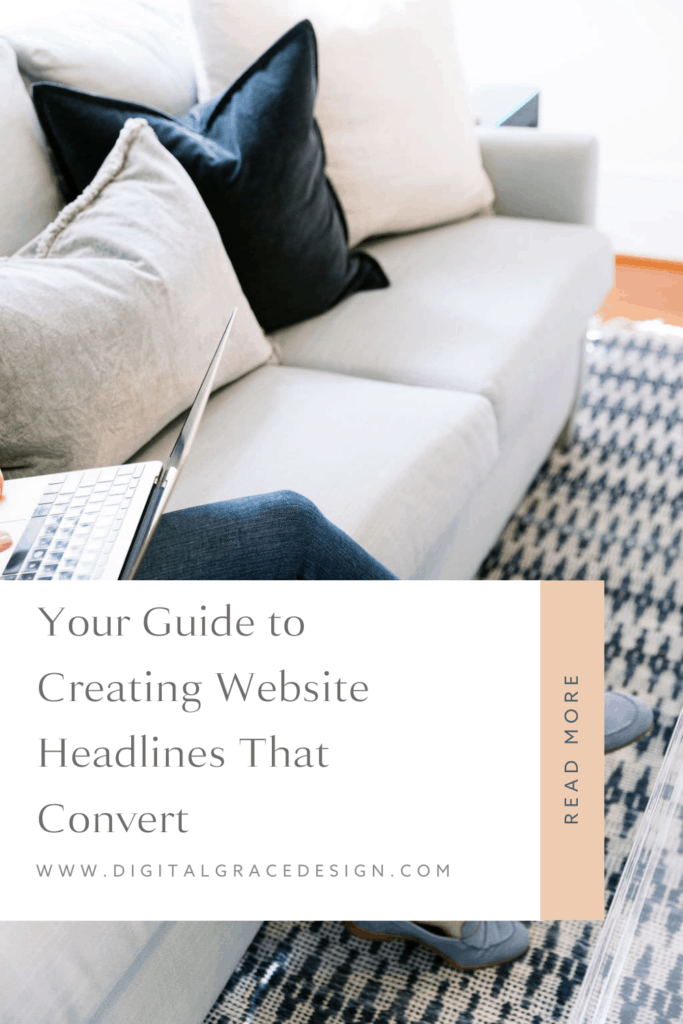Creative Entrepreneurs, Interior Designers, Photographers, Tips & Tricks, Website Design, Wedding Professionals
One of the first things your visitors will see when landing on your website is your headline.
That’s why it’s so important to get your headline right. It’s one of the main deciding factors when someone determines whether they want to continue scrolling through your website or close the browser tab.
So, what is a headline exactly?
A headline is the title you give to your written content. It’s meant to introduce the content and capture the reader’s attention. Headlines are used in newspapers and advertisements, or on website pages and blogs. Since I’m a website designer, it’s not surprising that I’ll be focusing today’s article on creating website headlines.
Side note—did you know some copywriters spend just as much time writing headlines as they do writing the corresponding copy?
That may sound silly since headlines are known for being short, but no one will get to read the content you’ve spent time creating if they aren’t hooked first by your headline. In fact, you may want to spend even more time on your headline because it is so concise. Short content can be deceiving. It may seem intuitive to be quick about creating a headline, but with so much riding on a first impression you can’t afford a poor headline that puts off your dream clients.
To ensure you’re creating captivating headlines on your website, let’s cover some best practices so you’re armed with tips that can help you in the brainstorming process.
Best practices for creating engaging headlines
Most importantly, your headline should entice the right readers to keep browsing through your website page or article. In a few words, your headline needs to introduce who you are, what you do, and who you can help—all while capturing (and keeping) the attention of each visitor.
Headlines have an important job in the content creation process, so let’s make sure you know what it takes to craft an effective headline.
Keep it short and sweet
Your headline should be easy to read at a glance, meaning it needs to be concise and clearly visible on your website. Many business owners try to pack too many details into their main website headline, but this only makes visitors want to skip over it.
Marketers typically recommend that your headline is between six to 12 words. That doesn’t give you a lot of wiggle room in terms of length, but this challenge can become an opportunity when you exercise your creativity.
Depending on the design of your website, you may be able to lengthen your headline. However, it’s better to keep it concise so it is easy for people to skim. If you hook them on the first headline, you may turn them from skimmers to readers! That’s the power of a good headline.
Use action words
The very best headlines inspire people to take action and think differently. It introduces them to new perspectives and shares thought-provoking insights. It may even cause readers to feel like the creator can somehow see inside their mind.
It may sound like a big task (and, in some ways, it is) but you’ll be that much closer to meeting this goal when you use action-oriented words. Since website conversions increase when people take action, using action words is an easy and effective way to write for better conversions.
Here are a few action words you may want to use in your headlines:
- Imagine
- Discover
- Boost
- Build
- Guide
- Create
- Go
- Access
- Craft
- Get
- Deliver
- Start
- Plan
- Act
- Amplify
There are hundreds of more action words you can use, but these may help you get started in writing headlines that convert.
Write at least 10 headline options
Have you ever noticed that the first headline you come up with is rarely your best one? You’re not alone! That’s because many of us (myself included) need to write multiple headlines before we get into a good creative flow.
I usually recommend writing at least 10 headlines to start with, especially if it is your first time writing headlines for your website. It’s best not to edit yourself when you’re writing and brainstorming. That way, you can stay in the flow and edit later.
Once you have your 10 (or more) headline options, spend some time away from the list so you can come back to it with fresh eyes. When you’re ready to review it, think about what headlines would captivate your attention as a reader. If you’re struggling to narrow down your ideas, ask a few people in your audience or even past clients to weigh in so you can ensure your headline is the best it can be.
If you want to go above and beyond, you can also A/B test your headline variations if you want to make a data-driven decision. This kind of testing allows you to compare the results of two different headlines so you can choose the headline that’s most successful.
Remember clarity trumps cleverness
Marketers often focus too much of their attention on creating clever headlines. While it’s great if you can create something that sounds clever, it must first be clear. This means it can be easily understood by anyone who is reading your headline.
If you have to use confusing jargon or pop culture references in order to make the headline work, you may want to switch the clever version for one with more clarity. This is another reason why I recommend writing so many headline options. You can quickly determine which headlines are clever but fail to be clear.
When in doubt, clarity wins! This goes for headline copywriting as well as any other kind of copywriting for your website.
Write with your target audience in mind
It’s pretty difficult to write a great headline without knowing who you’re writing for. This is why it’s important to define your ideal client from the very beginning. If you know who you’re writing to, it will be much easier to connect and engage with them through your writing. If it’s not completely clear if your business can help your audience through your headline or subheadline, you may need to edit it or swap it out with a different version.
Before you start writing, ask yourself these questions about your target audience:
- What is their age, gender, occupation, education level, income level, location, etc.?
- What are their most distinct personality traits?
- What are their habits, motivations, and goals?
- What are their biggest challenges, problems, or pain points?
- What kind of solutions are they looking for, and how does that relate to my business?
When you uncover these valuable insights, they will help you create better copy and headlines for your website. It might be tempting to create a headline you really like, but it’s much better to create one that will immediately connect with your audience.
Get inspired by the StoryBrand framework
Did you know that I’m not only a website designer but I also help my clients with their copywriting? I’m primarily able to do this because of the amazing StoryBrand framework. If you haven’t heard of it before, you’re in for a real treat!
StoryBrand was created by Donald Miller, a bestselling author turned marketer who teaches small businesses and large corporations to clarify their messaging so they can better attract their ideal clients and customers.
I became a Certified StoryBrand Guide a few years ago because of how valuable the framework has been in my own business. I love implementing it into my clients’ businesses when we work together on their design and copywriting.
If you want to learn more about the framework, you can read his books Building a StoryBrand or Marketing Made Simple. One of the best places to start, though, is by creating your own BrandScript. This activity allows you to identify who your ideal clients are, what they’re struggling with, and how you can help them by offering the best-fit solutions.
It can be so enlightening, especially when you are creating headlines. I always like to keep my own BrandScript nearby when I’m about to craft headlines for my site. It’s like my little cheat sheet I can come back to again and again!
Try customizing headline templates
If you’re still having trouble with writing headlines, it might be helpful to use pre-made headline templates. That way, you can customize the information so it’s relevant to your business without having to start completely from scratch.
I also recommend practicing with these templates so you can get comfortable with writing headlines. Then, when you’re ready to write your own, you have more confidence in your ability to write interesting headlines that will convert.
One of the best places to look for headline inspiration is from sites you love! That’s why some of the templates I’m sharing today are from my client websites. You can play around with the formatting of these templates and customize them to make something that’s all your own!

Inspired by Bloom & Grow Radio
Instead of: Grow the indoor jungle you’ve always dreamed of
Try: [Desired Result] you’ve always dreamed of

Inspired by Crossed Keys Estate
Instead of: A full-service New Jersey wedding venue unlike any other
Try: A [Type of Business] unlike any other

Inspired by Moxie Bright Events
Instead of: You deserve a stylish wedding that’s effortlessly you
Try: You deserve [Achievable Goal] that’s [Biggest Desire].
Let’s do one more!

Inspired by The Holistic Mrs
Instead of: Empowering women to live healthy, natural lifestyles through health coaching, essential oils, and community
Try: Empowering [Ideal Client] to [Biggest Goal] through [Signature Offers].
You can try this same exercise with other websites you are inspired by. If you’re looking for more inspiration, I recommend Pinterest or Instagram, as there are so many creative examples there.
What website headline will you create next?
After reading through these best practices, I hope you feel prepared and motivated to take the next step in creating your own headlines. You can always return to this article if you need more direction in choosing the right headline.
I can’t wait to see what you come up with!
